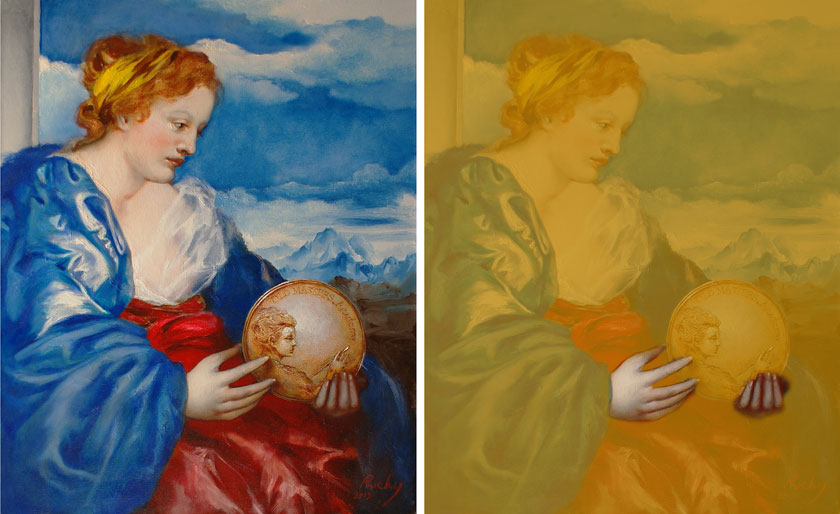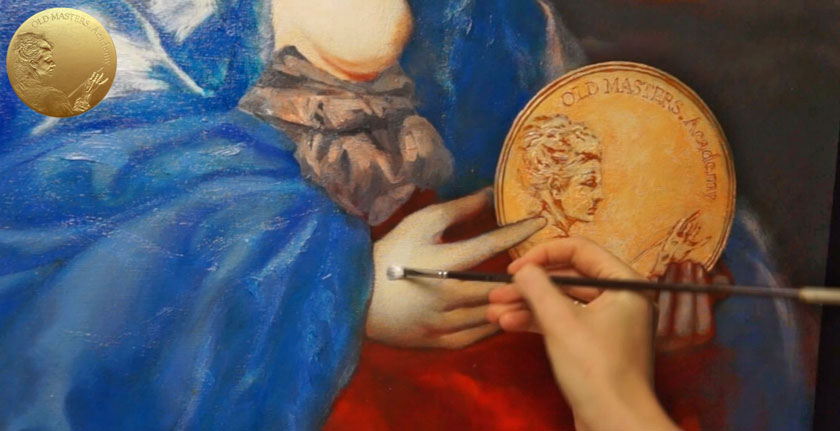Art Lesson 41, Part 8
Discover how to Paint Hands
Learn how to paint like the Old Masters!
Old Masters Academy Online Course
Self-study, self-paced online video courseLifetime membershipOne-time payment: $487Enroll Now!Personal Tutoring online + Online Course
Unlimited tutoring by the Academy teachersLifetime membershipOne-time payment: $997Enroll Now!« Back to the Art Lessons List
How to Paint Hands
It is time to focus our attention on painting the hands. As you remember, this process was started with the Brown Sketch. On top of this sketch, the hands were painted in Grisaille.

Session One
When the grisaille layer is completely dry, we can continue painting the hands in full color. We use Titanium White mixed with a tiny amount of Yellow Ochre, that is added to make the paint off-white.
At the same time, we add outlines in Venetian Red. Now, while we build up the thickness of the Underpainting with a white mix, we can organically intermix it with Venetian Red in mid-tone areas. Such mixing is done directly on the canvas. This method saves a bit of effort since we do not need to prepare a separate mix on a palette.
Venetian Red thinned with a Medium is used to paint the shade over the Underpainting of the Medallion. (you can also add a bit of Burnt Sienna for more brightness).
The thickness of the paint layer is built up in order to make it appear more tactile. There is no need in adding any Medium here, as the surface is covered in a dense, opaque layer of paint. Keep the layer moderately thick; too thick of a coat of paint can be difficult to control. The first session is complete. We can leave the canvas aside to dry.
Session Two
When the surface of the painting is dry, we can continue with the Underpainting. We use the same mix of Titanium White and Yellow Ochre that was used in the previous session.

We build up the paint, layer after layer. This creates the effect of materiality. After the surface dries, we can continue increasing the thickness and opacity of layers.
Session Three
Once again, we let the painting’s surface dry completely and afterwards, we continue with the hands. The same mix of Titanium White with Yellow Ochre is used as in the previous session.
The mix is spread over lighted areas. The shaded areas can be left untouched. The same steps are employed for the other hand. When the session is completed, we leave the surface to dry.
Session Four
It is time to continue painting the hands with a layer of Glaze. The same Glaze is applied for the medallion. As you remember, we use exactly the same Glaze for the portrait – here it is.
For the Glaze, we mix Burnt Sienna and Yellow Ochre thinned with Stand Linseed Oil.
The paint should be sufficiently thinned with a Medium to increase transparency of the paint coat. Of course, as always, we paint over previous layers that have completely dried.
We use a darker Glaze mix for the hands than we do for the portrait. Now we remove the extra Glaze coat from the lightened areas of the hand, but the shaded part of the hand will remain fully glazed.
After that, while the surface is still viscous, we start working on integrating white highlights into the Glaze. For this, we take pure Titanium White, without any Medium. After that, we put the painting aside to dry.




